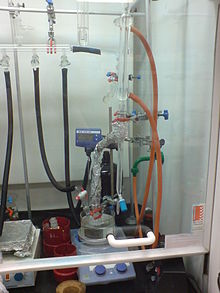Dean–Stark apparatus
The original setup by Julius Marcusson (invented in 1905) was refined by the American chemists Ernest Woodward Dean (1888–1959) and David Dewey Stark (1893–1979) in 1920 for determination of the water content in petroleum.The Dean–Stark apparatus typically consists of a vertical cylindrical glass tube, often with a volumetric graduation along its full length and a precision stopcock at its lower end, very much like a burette.This vapor travels out of reaction flask up into the condenser where water being circulated around it causes it to cool and drip into the distilling trap.[5] Another example is the esterification of benzoic acid and n-butanol where the ester product is trapped and the butanol, immiscible with the water, flows back into the reactor.Removing water in the course of these esterifications shifts the chemical equilibrium in favor of ester formation, in accordance with Le Chatelier's principle.
- Stirrer bar/anti-bumping granules
- Still pot
- Fractionating column
- Thermometer/Boiling point temperature
- Condenser
- Cooling water in
- Cooling water out
- Burette
- Tap
- Collection vessel

Wild Arms 5Burettelaboratory glasswaresynthetic chemistryreactorreflux condenserdistillation flaskchemical reactionrefluxesterificationstopcockBoiling chipsimmiscibleazeotropic distillationstoluenebutanolacetic acidsulfuric acidbenzoic acidn-butanolchemical equilibriumLe Chatelier's principleRoyal Society of ChemistryUniversity of RegensburgAlcohol burnerBunsen burnerDesiccatorHeating mantleHot plateLab ovenMeker–Fisher burnerTeclu burnerWater bathVacuum dry boxChemostatHomogenizerLiquid whistleMagnetic stirrerMortar and pestleShakerSonicatorStatic mixerStirring rodVortex mixerWash bottleClampsClamp holderTripodBurette clampIron ringRetort standTest tube holderTest tube rackWire gauzeLab drying rackAgar plateCryogenic storage dewarIncubatorLaminar flow cabinetMicrotiter platePetri dishPicotiter plateRefrigeratorAspiratorAutoclaveCork borerCrucibleFilter paperForcepsCentrifugeMicroscopePipeclay triangleSpectrophotometerSplintStopperScoopulaSpatulaTest tube brushWire brushInoculation needleInoculation loopGlasswareSoxhlet extractorKipp'sBoston roundCondensersCold fingerLiebigEvaporatingSyracuseWatch glassFlasksBüchnerVacuum (Dewar)ErlenmeyerFernbachFleakerFlorenceRetortRound-bottomSchlenkVolumetricHirschDroppingSeparatoryConical measureCuvetteEye dropperEudiometerGraduated cylinderOstwald viscometerPipetteDryingCragieNuclear magnetic resonance (NMR)ThieleThistleBeakerBell jarGas syringeAnalytical chemistryAutoAnalyzerCHN analyzerColorimeterInductively coupled plasma (ICP) deviceGas chromatograph (GC)